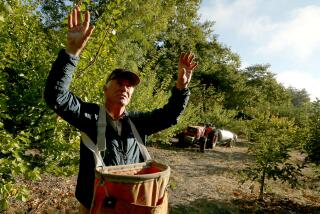This week: Mexican limes, Arkansas Black apples, Autumn Lady peaches

California’s season for limes is much earlier than for most other citrus. Some limes show up at farmers markets through the winter, and a very few year-round, but September to December is the time of plenty for locally grown fruit.
The prototype of the lime family, the small, round, seedy “true lime,” is usually called Mexican lime here, and elsewhere by many other names, including Key and West Indian lime. Scientists have long debated the ancestry of this species, Citrus aurantifolia, but recent genetic analyses show that its father, the pollen parent of the true lime, was citron, which was also the father of the lemon; and the mother was a papeda, possibly Citrus micrantha, one of a group of primitive citrus species with acrid rind oil, like the Kaffir lime. Somehow the true lime inherited desirable features from its parents, namely intense acidity combined with a piney, spicy, floral aroma.
Native to Southeast Asia, the true lime is much appreciated and widely grown in the tropics, where lemons do not flourish. It is little grown here in California because the tree is vulnerable to diseases and sensitive to cold, causing the fruits to drop prematurely; in addition, the fruits don’t store well because of their thin skins. Most of the limes sold or cultivated here are of the Bearss variety, which is identical or very similar to the kinds known elsewhere as Tahiti or Persian. Larger, oval and usually seedless, with a milder aroma, it’s a natural hybrid of citron and true lime.
Florida formerly produced much of the nation’s lime supply, but in the last 15 years disease and hurricanes almost destroyed its production, which was supplanted by imports from Mexico, the world’s largest grower. California has about 400 acres, mostly in San Diego County, where trees flourish in the mild climate.
In the tropics, limes remain green on the tree, but in California, where it gets cool at night during the harvest season, limes can turn yellow. Commercial marketers prefer limes to be green, partly out of tradition, and because that way they are not confused with lemons, but local limes, harvested fully ripe and yellow, are most juicy and aromatic. (It’s easy to distinguish them from lemons, both by the aroma and because lime flesh retains a light green tinge.) Farmers market limes are the best of all, because they don’t have to undergo washing and waxing in commercial packinghouses, which inevitably diminishes the aroma. They’re less expensive too: It’s common to find them for five or even 10 to the dollar.
Round, deep purplish-red to almost black in color, and hard as a rock, the Arkansas Black apple is dramatically distinctive. It originated in 1870 at an orchard near Bentonville, Ark. (best known today as the home of Wal-Mart), probably as a sport of Winesap, and was a popular commercial variety in Washington State orchards a century ago, because it was a good keeper and shipper. Controlled-atmosphere storage subsequently eroded this advantage by enabling other varieties to be stored longer, and so the Arkansas Black dropped out of large-scale commercial production. (Also, although its yellowish flesh becomes more aromatic in storage, the skin becomes waxy or greasy.)
With renewed interest in heirloom apple varieties, it’s been making a comeback lately, especially at farmers markets. “I’ll plant some more, there’s huge demand,” says Vito Scattaglia, who currents farms 3 acres of Arkansas Black. His Scattaglia Family Farms will sell them through the end of the month at farmers markets in Encino, Thousand Oaks, Hollywood, Santa Monica (Main Street), Camarillo, and Ventura (Downtown).
Just-picked peaches in November? It seems preposterous, but Tenerelli Farms of Littlerock just started selling their Autumn Ladys, making them probably the latest peaches in the Northern Hemisphere. Surprisingly, it’s a good peach, not mealy like many late varieties.
Grant Merrill, the breeder of many well-known varieties such as O’Henry and Elegant Lady, introduced Autumn Lady in 1979 as an ultra-late peach, ripening in mid-October in the Sacramento Valley. Varieties mature several weeks later in the high desert, both because trees bloom later at higher elevation, and because the intense summer heat actually retards development; this makes high-desert Autumn Ladys just about the only fresh peaches on the market until the first Chilean fruit arrives in a week or two. This late in the year there’s a risk that a rainstorm or freeze will spoil the crop, but wholesale prices can be so high, says John Tenerelli, that he sometimes sells part of his crop through commercial channels. He and his family will offer the fruit through next weekend (Nov. 14-15) at farmers markets in Long Beach (Marina), Beverly Hills, Santa Monica, Hollywood, Venice, Pasadena (Victory Park) and Alhambra.
More to Read
Eat your way across L.A.
Get our weekly Tasting Notes newsletter for reviews, news and more.
You may occasionally receive promotional content from the Los Angeles Times.






